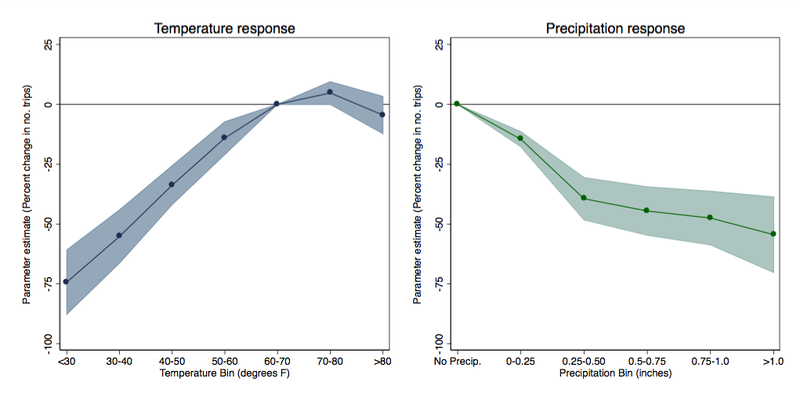The outdoor recreation industry is huge: US consumers spend almost $900 billion dollars on various outdoor activities each year. As anyone who has canceled a hike, rock-climbing excursion, or camping trip in the face of a rainy forecast knows all too well, weather has a substantial impact on our ability to get outside and play. Now, if we want to understand how climate change might affect outdoor recreation, we just need to add up all of the cold days and rainy days induced by climate change that inhibit outdoor activity.
But that’s much easier said than done. We tackled this in a new RFF working paper, looking specifically at the demand for recreation in the form of bicycle trips. Although the relationship between weather and recreation is intuitive (i.e., people enjoy spending more time outside when the weather is nice), it is particularly difficult to measure this relationship because recreation is what economists like to call a “nonmarket” good—essentially, we do not have a good system of logging how much time people spend outside during pleasant weather.
In the new study, we gather data on 27 million recreational weekend bicycle trips from 16 bike-sharing programs across the United States, Mexico, and Canada. We match this daily demand for recreation with the prevailing weather conditions and, by doing so, are able to quantify the impact of weather on cycling demand.
Our results are also intuitive: when the daily average temperature drops, so do the quantity and duration of recreational bicycle trips. At below-freezing temperatures, we find that the number of bicycle trips decreases by about 75 percent relative to moderate temperatures. Any rainfall also reduces demand for recreation. Somewhat surprisingly, we find that recreational cyclists tolerate hot temperatures quite well. The overall relationship between cycling demand and weather—shaped like an inverted U—is presented in Figure 1.

Now that we have estimated the relationship between cycling and weather, we need to understand what the distribution of temperature and precipitation will look like in the future. By combining our estimates with predictions of future weather, we can calculate the potential impacts of climate change on outdoor recreation. Fortunately for us, the World Climate Research Program compiles a vast array of global climate projections from a variety of climate models intended to serve the Intergovernmental Panel on Climate Change. We use a set of climate model outputs that predict what the weather will look like between 2055 and 2060, and overlay the relationship shown in Figure 1 with these midcentury weather projections
Could climate change possibly be good for outdoor recreation? Our analysis indicates exactly that—we estimate that climate change will increase the demand for recreational cycling by about 5.5 percent. The logic is fairly straightforward: climate change will reduce the number of cold days we experience each year and increase the number of hot days. As Figure 1 illustrates, people dislike cold temperatures much more than they dislike hot temperatures. So, milder winters and warmer “shoulder” months such as March and October will induce people to go outside, while hotter summers will do little to deter outdoor enthusiasts. Our analysis pertains to only warm-weather recreation (e.g., cycling, running, hiking, and so forth). Winter recreation—which will be impacted negatively by warmer temperatures—is not captured in our analysis.
We took these results a step further by applying our estimates to data compiled in the 2016 American Time Use Survey, which catalogs how much time people spend engaging in specific activities. By multiplying the anticipated change in recreation demand to representative levels of outdoor recreation in each state, we can provide an estimate of how overall outdoor recreation demand will respond to climate change. Combining these estimates with a measure of the value of recreation time, we can quantify the economic magnitude of these changes. According to our calculations, US consumers will enjoy additional climate-induced recreation benefits of $20.7 billion per year by 2060.
These results vary across the United States, as shown in Figure 2. States in the Northeast and on the West Coast—particularly New York, Pennsylvania, and California—are expected to gain the most. States in the Southeast (which is already expected to be the hardest hit region in the nation) are expected to lose or gain very few recreation benefits from climate change.

Our work represents an exciting data exercise on an academic level, but our results also have immediate policy implications. In order to understand the overall impact of greenhouse gas emissions, we need to have a comprehensive measure of the costs of climate change—and, as we show here, the potential benefits. However, many climate damages that occur outside of traditional markets (such as effects on ecosystem services and outdoor recreation) have been largely absent from estimates of the costs of climate change, primarily because they are difficult to measure. Empirical studies such as this are critical for informing the social cost of carbon.
It is important to state the obvious: climate change will impose huge net costs on the United States and beyond. But in order to have a meaningful estimate of the social costs of climate change, we need full accounting of its many impacts. In that light, our study offers fresh insights on the analytical challenge of valuing the nonmarket consequences of climate change.





